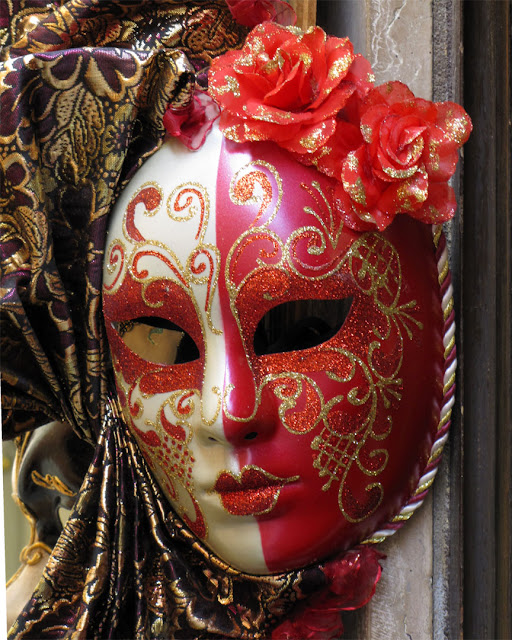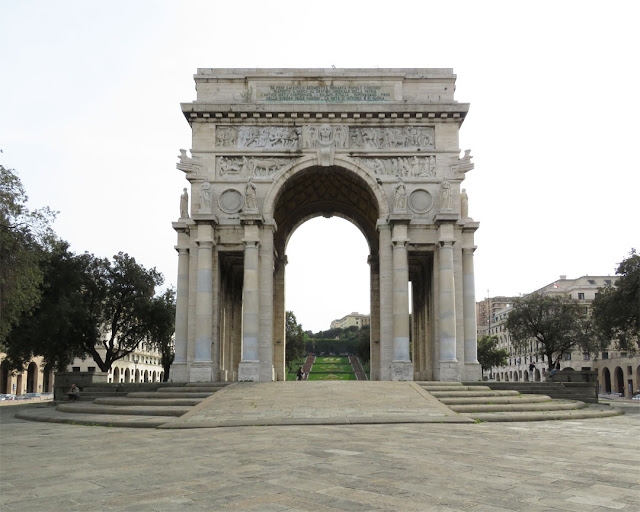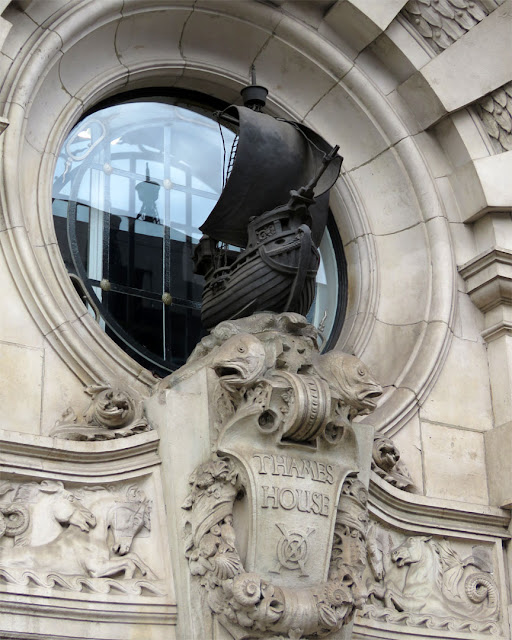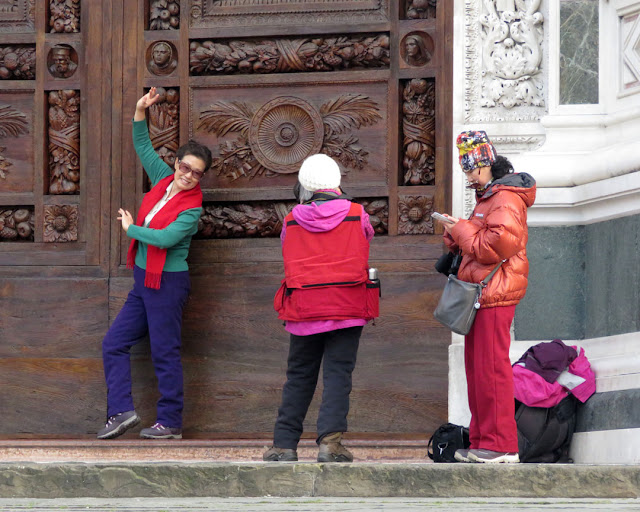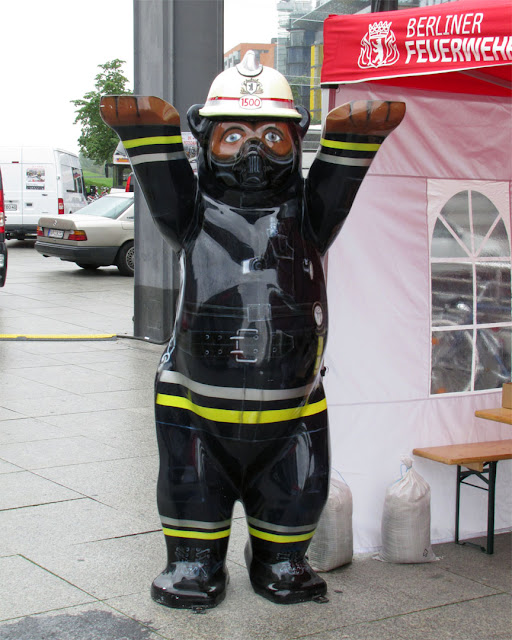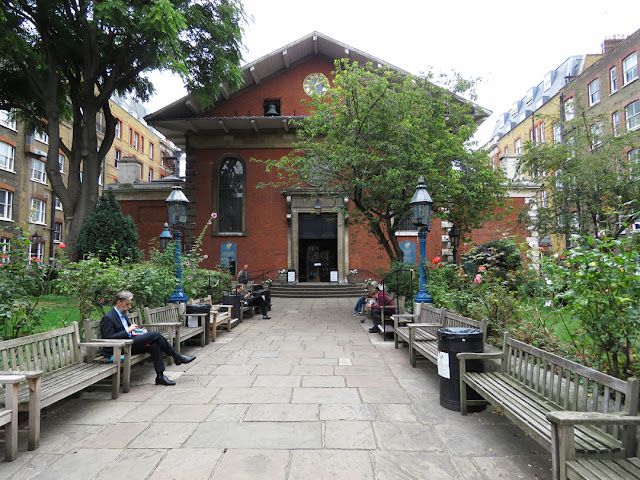Tuesday, February 28, 2017
World Fountain
Detail of the Weltkugelbrunnen (World Fountain) by Joachim Schmettaus, 1984
Breitscheidplatz, Charlottenburg
Berlin, September 2011
Monday, February 27, 2017
Basilica of San Francesco
Basilica di San Francesco (Basilica of Saint Francis)
Piazza Malpighi
Bologna, June 2015
“The architect is not known. Early sources gave Friar Mateo of Brescia as having designed the church. This seems to have been a confusion with Giovanni of Brescia, a leading architect of the period. The 14th-century chronicler of the friary, Bartolomeo of Pugliole, recorded that, when the vault of the apse collapsed in 1254, the restoration work was supervised by one Friar Andrea Maestro della Ghiexia, who is described as ‘of the twisted legs’. Despite its Romanesque facade, it is one of the best example of French Gothic architecture in Italy. This is manifest in the interior, which has a nave and two aisles, in the apse with corridor, in the high vaults divided into six sections (like in Notre-Dame de Paris) with ogival arches, and in the use of buttresses.” (Basilica of San Francesco, Wikipedia)
Sunday, February 26, 2017
Sackler Octagon
Dancers at the Sackler Octagon, Duveen galleries
Tate Britain, Millbank
London, September 2016
“The dancers make studied movements within areas marked off by white tape on the floor that recall the forms of baroque gardens. Their stylised hand movements and dignified steps are inspired by ‘sprezzatura’, a concept derived from 16th century Italy where courtiers were expected always to act with an air of understated grace and elegance. They wear the leggings and dance shoes of classical ballet, but their red sweatshirts and bespoke oversized jewellery recall the fashions of the 1980s, encouraging the viewer to think about the strange, anachronistic mixes present in the exhibition. Similarly, the choreography bears a resemblance not only to baroque courtly dances but also to experimental performance pieces by artists such as Bruce Nauman. ” (Pablo Bronstein: Historical Dances in an Antique Setting at Tate Britain, The UpComing)
Saturday, February 25, 2017
Cat and Mouse
No entry sign hacked by Clet Abraham
Via dei Servi / Via degli Alfani
Florence, January 2017
“‘Street art, or guerilla art, needs to be reinvented in dialogue with the Renaissance city,’ says Clet Abraham, the French-born artist who has come into the public eye for his surprising interventions in public spaces. I sat down with him to learn more about his project and to discuss the role of street art in Florence. You may not know it, but you've probably seen work by Clet out on the streets. Since last summer, he's been conducting night-time blitzes to alter traffic signs: a silhouette of a man carrying away the no-entry bar; a dead-end ‘T’ sign becomes a pietà or a crucifix. The figure is created with a black sticker that is easily removable.” (CLET, The Florentine)
Friday, February 24, 2017
Crow at Sunset
Crow at sunset
Cour Napoléon (Napoleon Courtyard)
Palais du Louvre (Louvre Palace)
Quartier Saint-Germain-l'Auxerrois, 1st arrondissement
Paris, July 2014
Thursday, February 23, 2017
Carnival of Venice
Carnival mask outside a shop
Somewhere in Santa Croce
Venice, September 2012
“The volto (Italian for face) or larva (meaning ghost in Latin) is the iconic modern Venetian mask: it is often stark white though also frequently gilded and decorated, and is commonly worn with a tricorn and cloak. It is secured in the back with a ribbon. Unlike the moretta muta, the volto covers the entire face including the whole of the chin and extending back to just before the ears and upwards to the top of the forehead; also unlike the moretta muta, it depicts simple facial features like the nose and lips. Unlike the bauta, the volto cannot be worn while eating and drinking because the coverage of the chin and cheeks is too complete (although the jaw on some original commedia masks was hinged, this is not a commedia mask and so is never hinged—the mouth is always completely closed).” (Carnival of Venice, Wikipedia)
Wednesday, February 22, 2017
Unity
“Unity” by Ivan Klapez, 1992
Alban Gate atrium
London Wall, City of London
London, September 2016
“Tucked away in an upper walkway through the Terry Farrell-designed building that straddles London Wall is this whirling pair of dancers, though what the dance may be defies deduction. Perhaps you have to be listening to the music. The 1992 work, Unity, was commissioned by developers MEPC from the Croatian sculptor Ivan Klapez. It is a most awkwardly positioned artwork, in a low atrium with industrial ceilings. It is circled by a huge window which bathes it in light but makes it very difficult to photograph - either it is against the light or the background is filled with fussy office detail. The original idea was to use a figure by Klapez called Liberty, a very tall male nude, but the artist felt the ceiling was too low to give it room to breath and suggested this dynamic X-shaped composition instead.” (Alban Gate, London Wall, Ornamental Passions)
Tuesday, February 21, 2017
Bacchino Fountain
Fontana del Bacchino (Bacchino Fountain) by Valerio Cioli, 1560
(A satiric portrait of court dwarf Pietro Barbino ‘Morgante’ as Bacchus)
Giardino di Boboli (Boboli Gardens)
Florence, January 2017
“His most famous work is the ‘Fontana del Bacchino’ in the Giardino di Boboli, near the entrance to piazza Pitti in Florence. It shows a dwarf at the court of Cosimo I, ironically nicknamed Morgante (the giant of the poem Morgante by Luigi Pulci), portrayed nuded and sitting on a tortoise like a drunken Bacchus.” (Valerio Cioli, Wikipedia)
Monday, February 20, 2017
Empire State Building
Empire State Building by William F. Lamb, 1931
Fifth Avenue between West 33rd and 34th Street
New York, October 2007
“The Empire State Building was designed by William F. Lamb from the architectural firm Shreve, Lamb and Harmon, which produced the building drawings in just two weeks, using its earlier designs for the Reynolds Building in Winston-Salem, North Carolina, and the Carew Tower in Cincinnati, Ohio (designed by the architectural firm W. W. Ahlschlager & Associates) as a basis. Every year the staff of the Empire State Building sends a Father's Day card to the staff at the Reynolds Building in Winston-Salem to pay homage to its role as predecessor to the Empire State Building. The building was designed from the top down. The general contractors were The Starrett Brothers and Eken, and the project was financed primarily by John J. Raskob and Pierre S. du Pont. The construction company was chaired by Alfred E. Smith, a former Governor of New York and James Farley's General Builders Supply Corporation supplied the building materials. John W. Bowser was project construction superintendent.” (Empire State Building, Wikipedia)
Sunday, February 19, 2017
San Marcello al Corso
St Philip Benizi refuses the papal tiara, by Antonio Raggi, 1686
Bas-relief over the entrance of San Marcello al Corso
Piazza di San Marcello
Rome, April 2013
Saturday, February 18, 2017
Friday, February 17, 2017
Stacked
“Stacked” by Ai Weiwei, 2012
“Ai Weiwei. Libero” exhibition
Palazzo Strozzi
Piazza degli Strozzi
Florence, January 2017
“A parallel is implied between old furniture and old lives, and a persistent theme in Ai’s career has been the condition of ordinary Chinese life. The 950 bicycles neatly stacked in interlocking columns symbolise the simple liberation from the highly constricted social and political atmosphere of the Maoist era that Ai’s generation (he was born in 1957) discovered in being physically mobile.” (Up, up Ai Weiwei, The Florentine)
Thursday, February 16, 2017
Zietenplatz
Horse-drawn carriage
Zietenplatz
Berlin, September 2011
“The central section extending to Mauerstraße was called Zietenplatz from 1849 until 1945. The name comes from the statue unveiled in 1794 of the Cavalry General Hans Joachim von Zieten. It formed a unique ensemble of monuments on the square area together with five other statues of generals. Today, the building for representatives of the Province of Thuringia is on the northern corner towards Mauerstraße. The monument of the Hussar General von Zieten was erected again in 2003, followed by the sculpture of the Old Dessauer on 8 June 2005. The newly designed Zietenplatz, based on a design by the landscape architect Reinald Eckert, Berlin was presented to the public in June 2007.” (Zietenplatz and Hausvogteiplatz, Berlin.de)
Wednesday, February 15, 2017
Madonnina
Madonnina by Giuseppe Perego, 1774
Duomo di Milano (Milan Cathedral)
Piazza del Duomo
Milano, November 2016
“The Madonnina spire or guglia del tiburio (‘lantern spire’), one of the main features of the cathedral, was erected in 1762 at the height of 108.5 m (356 ft). The spire was designed by Francesco Croce. At the top of the spire is the polychrome Madonnina statue, designed and built by Giuseppe Perego in 1774, during the episcopacy of Giuseppe Pozzobonelli who supported the idea to place the Madonnina at the top of the Cathedral. By tradition, no building in Milan is higher than the Madonnina. When Gio Ponti’s Pirelli Building was being built in the late 1950s, at a height of 127.1 m (417 ft), a smaller replica of the Madonnina was placed atop the Pirelli building, so the new Madonnina remains the tallest point in Milan. In 2010 another replica was placed as well on the top of the Palazzo Lombardia, at a height of 161 m (528 ft), being then the tallest building in the city.” (Madonnina, Wikipedia)
Tuesday, February 14, 2017
Monday, February 13, 2017
Sunday, February 12, 2017
Tour Cristal
Tour Cristal by Julien Penven and Jean-Claude Le Bail, 1990
Tour Beaugrenelle (1979) and Tour Keller (1970) in background
Front de Seine
Quartier de Grenelle, 15th arrondissement
Paris, July 2014
“Front de Seine (also known as Beaugrenelle) is a district in Paris, France, located along the river Seine in the 15th arrondissement at the south of the Eiffel Tower. It is, with the 13th arrondissement, one of the few districts in the city of Paris containing highrise buildings, as most have been constructed outside the city (notably in La Défense). The Front de Seine district is the result of an urban planning project from the 1970s. It includes about 20 towers reaching nearly 100 m of height built all around an elevated esplanade. That esplanade is paved with frescos that can be seen only from the elevated floors of the towers. As opposed to Italie 13, the design of the towers is much more varied. The Hôtel Novotel Paris-Tour Eiffel (formerly known as Hôtel Nikkō), for instance, has red-encircled windows, while the Tour Totem consists of a stack of several glassed-blocks. A newly redesigned shopping centre, the Centre commercial Beaugrenelle has opened in 2013.” (Front de Seine, Wikipedia)
Saturday, February 11, 2017
Arco della Vittoria
Arco della Vittoria (Victory Arch) by Marcello Piacentini, 1931
Piazza della Vittoria
Genoa, April 2016
“In 1923, the comune of Genoa decided to build a commemorative monument while redeveloping an area that was previously a wet meadow. It announced a national contest for the design of an arch to be built on a lawn located adjacent to the Bisagno stream. The stream is now buried under Via Brigate Partigiane. Sixteen proposals were submitted, and the jury chose the draft by the architect Marcello Piacentini and the sculptor Arturo Dazzi. The commission chose it because the design was inspired by Imperial Roman and 16th century architecture, giving the monument a strong, heroic and triumphant appearance. Piacentini later modified the design of the arch, making it simpler. Construction was carried out by the local Impresa Garbarino e Sciaccaluga, under the direction of Piacentini himself.” (Arco della Vittoria, Wikipedia)
Friday, February 10, 2017
Bronze Galleon
Galleon by William Bainbridge Reynolds, 1912
Southern Pavilion, Thames House
Queen Street Place, City of London
London, September 2016
“The lintel over the main door is decorated with swirling hippocampi and supports a curious bronze sailing ship by the metalworker William Bainbridge Reynolds. It is the shortest ship in history, with just one mast, but the stern is as ornately carved as any galleon so it must make a splendid sight from the room inside.” (Thames House, Queen Street Place, Ornamental Passions)
Thursday, February 9, 2017
Wednesday, February 8, 2017
The “Piglet”
Copy (1972) of the “Porcellino” (Piglet) by Pietro Tacca, 1634
Sutton Place park, East 57th Street
New York, September 2007
“Il Porcellino (Italian ‘piglet’) is the local Florentine nickname for the bronze fountain of a boar. The fountain figure was sculpted and cast by Baroque master Pietro Tacca (1577–1640) shortly before 1634, following a marble Italian copy of a Hellenistic marble original, at the time in the Grand Ducal collections and today in display in the classical section of the Uffizi Museum. The original, which was found in Rome and removed to Florence in the mid-16th century by the Medici, was associated from the time of its rediscovery with the Calydonian Boar of Greek myth.” (Porcellino, Wikipedia)
Tuesday, February 7, 2017
Monday, February 6, 2017
Sunday, February 5, 2017
Looking Up
Ceiling of San Miniato al Monte (St. Minias on the Mountain)
Viale dei Colli
Florence, December 2016
Saturday, February 4, 2017
Friday, February 3, 2017
Thursday, February 2, 2017
St Paul's Churchyard
West entrance of St Paul's church and garden
Covent Garden
London, September 2016
“Affectionately known as ‘The Actors' Church’, St Paul's in Covent Garden is in the heart of theatreland and has long been associated with the theatre community. This beautiful church, built by Inigo Jones, has been here since 1633 and has regular worship, concerts, literary and theatrical events. Many famous names have been connected with St Paul's - John Wesley preached here, J.M.W Turner and W.S Gilbert were baptised here, and those buried here include Sir Peter Lely, Samuel Butler, William Wycherly, Grinling Gibbons, Thomas Arne, and Thomas Rowlandson. One of many plaques in the church commemorating legends of the stage and screen is one in loving memory of Vivien Leigh. The church's history and philosophy is endearingly written by the church doors and includes the principles: we are unafraid to reason, laugh and explore and we welcome people of faith, all who seek faith and friendship, and all who doubt. Benches in the attractive churchyard make this a popular and peaceful spot for Soho's workers to enjoy a sandwich during a summer lunch break. It's a welcome refuge of peace and quiet away from the busy streets around Covent Garden.” (St Paul's Covent Garden, LondonTown)
Wednesday, February 1, 2017
Vittorio Emanuele II
Monument to Vittorio Emanuele II by Emilio Zocchi, 1890
Piazza Vittorio Veneto
Florence, January 2017
Subscribe to:
Posts (Atom)






